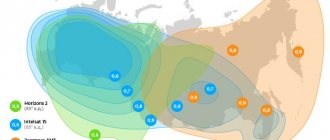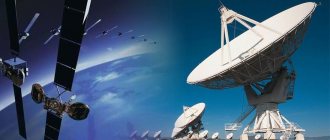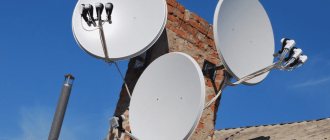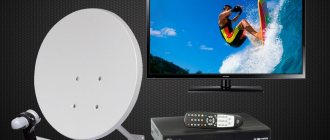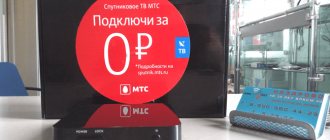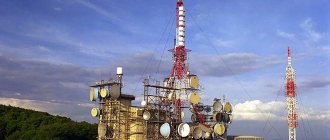Choosing satellite television means having the opportunity to have a huge number of channels in HD and SD resolution. Unlike cable TV, satellite TV is available everywhere. All you need is a satellite dish and a decoder. Installation and configuration of equipment have an affordable price. And if you are well versed in electronics, then they will not affect your budget at all - do everything yourself. If you decide to purchase a ready-made satellite TV package with equipment from Russian operators, then know that from time to time they offer very attractive promotions and installment plans.
Satellite dishes
One way or another, you need information about what features different satellite dishes have in order to choose your option.
General characteristics
A satellite dish for a TV is the first link in the entire home satellite installation. The choice of her model deserves your attention. A properly selected design will last over ten years. The exception may be rare atmospheric conditions such as tornadoes and storms.
Despite their apparent external similarity, satellite antennas have a lot of design differences. Not all devices for receiving communications from a satellite are round and point straight towards the sky. There are complex array and multivibrator antennas that have different radiation patterns. For which a high noise level is allowed, because they perform no less important functions than receiving television programs.
How does a satellite dish work?
A satellite television antenna is used to receive a television signal from a space satellite. The parameters of the dish itself and its converter largely determine the quality of image and sound that the satellite decoder will give you on your TV screen. Let's consider the principle of their operation.
Satellite dish operation
The signal level received from a satellite on earth is very small compared to its original level: attenuation is about 200 dB. This is understandable: the distance that separates the earth from the satellite is about 36,000 km. You can only receive a signal strong enough to watch programs if you concentrate it as much as possible. It is this function that is performed by the satellite wave receiver, which is a curved surface, colloquially called a dish.
The waves sent by the satellite to the earth are reflected by the inner surface of the antenna, obeying the laws of optics, and are concentrated at a point called the focus. At this point the receiving head of the transducer is located, a device for converting high-frequency vibrations into a cable signal.
What types of satellite dishes are there?
Since the discovery of satellite communications, many types of wave receivers have been created for receiving and transmitting signals. Each type has found its own ground application depending on the purpose of the satellite communication system:
- mobile connection;
- satellite telephony and radio broadcasting;
- navigation via orbital communications;
- Internet;
- meteorology;
- communication with spacecraft;
- TV.
You may be interested in: Transponder – what is it?
Ordinary TV viewers are more familiar with mirror-type (offset) devices. The most famous family of satellite dishes, which is presented in stores. They differ in the shape of the reflector, are different in diameter, have different surface utilization rates and are accepted in different ranges.
Offset
Offset satellite dish
This satellite TV antenna has a reflective bowl in the shape of an ellipsoid. Radio waves from satellites that bounce off the working mirror are concentrated not in the geometric center of the figure, but in its lower focus. A bottom focus dish does not require a large elevation angle. This design of the mirror in offset satellite antennas made it possible to achieve more stable reception, because The signal converter does not cast a shadow on the surface of the bowl and does not cause noise.
Direct focus
direct focus satellite dish
This type of wave receiver has a working mirror surface in the shape of an oblate paraboloid. This symmetrical reflector geometry makes it possible to achieve good capture of radio waves arriving at its surface and maximum redirection of them to the converter. It is mounted on holder consoles directly above the central point of the plate.
Toroidal
Toroidal satellite dish
A toroidal dish, a type of multibeam antenna, is a progressive solution that replaced mirrors on rotating mechanisms. Figuratively speaking, this is not just a “plate”, but a whole service, consisting of a large dish, a saucer and several converter cups. This model has two reflectors (reflectors) and this is a huge advantage for receiving TV from different satellites. Before radio waves hit the receiving surface of the converting head, they will be reflected twice: first hitting a large mirror, and then refracting from it to a small one, where they are focused on the desired converter.
Manufacturers of toroidal antennas guarantee that they are equipped with up to sixteen converters. This opens up very great opportunities for the viewer: redirecting such a device to work with signals from different satellites can now be done without getting up from your chair in front of the TV.
PAR
Phased antenna
Phased array antennas are actually a rarely used class of satellite equipment. They were popular in the 90s of the last century, which they owe to Nokia. Having a list of limitations, narrowband, labor-intensive production, and hence high cost, phased arrays are not actively used by consumers of television equipment.
Based on the use of controlled phased arrays, the development of mobile and portable satellite communication receivers is being carried out.
Traveling wave antennas
Directional antenna
This is a directional type receiver. The signal in it propagates in the form of a traveling wave along the geometric axis of the structure. In terms of its structure, it is a collecting line on which several vibrators equidistant from each other are attached. This antenna is broadband (VHF and UHF waves) and does not require adjustment. Common among meteorologists and in amateur radio communications.
Weakly directional antennas
Weakly directional wave antenna
Weakly directional wave receivers have found their application in those places of satellite reception where it is not possible to constantly redirect the position of the receiving device. The antenna produces a lot of noise due to its wide radiation pattern. But this is not critical for capturing relayed waves from low-orbit satellites.
You may be interested in: Tricolor smart card
Diseqc connection
If you only have a dashcam, connecting and configuring satellites is carried out in the following sequence.
Remember that any self-respecting store of satellite equipment and similar systems always sells tuners already programmed for certain channels and satellites. Otherwise, competitors will simply drive him out of the market.
At the same time, when purchasing, be sure to ask the seller to write you the Diseqc ports of the switch, since they were set by him during the settings. It is through these ports that you will have to make all cable connections.
When installing, you first connect the cables to the heads, and then run them to the dashik. Just on it, it is advisable to connect everything initially with the “factory” tuner settings.
If you have any satellite in the receiver configured to the first port, then accordingly it should not go to port No. 1. If it is on the second one, then port No. 2 is also used in the switch, etc.
All input ports are always signed. The central single connector is the output to the tuner itself.
How to choose a satellite dish
Most satellite TV antennas look very similar. Modern offset-type plates are especially popular (the converter is located not in the center of the dome, but at the bottom). The reflectors have a diameter of 45 to 120 cm. Their important element is the converter - a device in front of the dish that collects and amplifies the reflected signal, delivering it to the satellite receiver.
When choosing a satellite dish, you must first consider the location of its installation. She must “look” to the southern side of the sky without encountering obstacles. They can be a wall, a chimney, a hill, or even a tree. In this regard, the best place for the antenna would be the roof. The more difficult the terrain, the larger the antenna diameter must be chosen. Small reflectors are best suited for installation on tall buildings, since large dishes at high altitudes are more susceptible to wind loads.
F connector connection
To connect coaxial cables, you need to strip them and put F-connectors on them. There are two ways to do this.
Method 1 – cut off only the outer sheath of the cable with a knife at a distance of 20-25mm. The screen must not be damaged.
Carefully bend all the wires onto the shell.
Now you need to remove the insulation from the central core. It should protrude from the screen by a maximum of 2mm.
After this, screw on the F connector.
Shorten the excess stock of the central core, leaving no more than 5mm from the plane of the connector.
Method 2 is easier. Take the utility knife again. Step back approximately 1cm from the edge of the cable and cut off all the insulation. Including external and internal, up to the central core.
Then, retreating 3mm, cut off only the outer braid.
Make sure that no lint or wires get between the braid and the central core.
There is no need to remove any more insulation or bend anything. Just insert and screw on the f connector from above.
Next, you lay out cables throughout the apartment in all the rooms where you have TVs. You sign them all too.
At the same time, it is much safer to run the cable directly into the device rather than connect it through a satellite TV outlet. This may be associated with either a loss of quality or a complete loss of signal.
The wiring diagram when using a multiswitch may look like this:
Material of manufacture
What a satellite dish consists of, namely the construction material, essentially has no effect on the quality of the received signal. The main thing is that it fulfills its reflective function. But there is another important criterion: satellite dishes are always installed outdoors, which means they must be resistant to various external factors.
The coating of the dish is designed to effectively protect it from corrosion, and in this regard, antennas made of aluminum have proven themselves well; they make up the majority of manufactured models. But they have one minor and completely removable drawback - a certain softness. A gust of strong wind can tear the antenna bowl off its mounts: the screws that come with the fasteners can be torn out through the soft metal and your satellite dish may well become “flying.” From the outside it may look comical (a UFO is flying), but in reality it is dangerous, because the device is installed at a height and it is unknown where it will land.
Despite this, we recommend aluminum plates, but with rigid mounting. You can strengthen the mount yourself by using stronger screws and larger washers. A satellite dish made of aluminum, even after several years, will look like new, but will cost you more.
A more economical option is a steel antenna. There is no doubt about its strength; its service life is more than 10 years. If this seems not enough to you, then do not forget that progress is unstoppable, and during this time technology will definitely step forward, as is the case with information compression. But when buying a steel plate, inquire about its protective coating; if it is of poor quality, it may rust.
Plastic satellite dish
Plastic dishes with metal coating are an innovation in the satellite TV equipment market. The ubiquitous plastic has penetrated here too. Whether this is good or bad, time will tell. According to some observations, the price of these antennas is quite high, and the performance is worse than that of aluminum dishes; there is no need to talk about durability. So nothing interesting, except for easy installation.
In areas where frequent and strong winds blow, where installation is carried out at high altitudes, a perforated metal antenna is recommended. The “sieve” effect helps reduce the windage of the antenna.
Introduction
After you have chosen which satellite Internet provider you are going to work through, it’s time to start choosing a satellite dish, or, as they are used to calling it, “dishes”. In reality, choosing a satellite dish is a very simple matter. You don't need to know any formulas and don't need any calculations. You can generally rely on the sellers to select an antenna for you, but it’s better to make the choice yourself. Today, some companies offer ready-made kits for satellite Internet. For example, they sell kits for Europe OnLine, consisting of a Technisat SkyStar 2 DVB card, a satellite dish and a subscription to use the service for several months. The seller of such a kit, as a rule, undertakes to install an antenna for you, configure the software and deliver the satellite Internet, as they say, on a turnkey basis. When buying such kits, you overpay significantly, because satellite Internet in Russia is still the domain of organizations or wealthy private individuals, and therefore the price of such kits is increased. Moreover, at first glance it may seem that the prices are real, because a DVB board and dish will cost almost the same as in other stores, but the cable and installation work will cost you more than if you called another specialist, and the cable We’d buy it ourselves, but we’ll talk about that later. For now, let's move on directly to the choice.
Why size matters
The key to trouble-free TV reception from satellite is the purchase of high-quality equipment, its correct installation and selection of the optimal size of the dish itself. It is with this last point that troubles often arise. Some TV viewers are so concerned about aesthetics that they immediately reject the decision to buy a large antenna, but often the diameter of the antenna is the determining criterion in areas with problematic signal reception. The larger the antenna, the better it captures the signal, for example in case of bad weather. A dish with a diameter of 60 cm, although it looks compact, does not guarantee the absence of signal interruptions. The optimal solution for stable reception of channels from a satellite, if you have space, is to install a satellite dish with a diameter of 80-90 cm.
You may be interested in: Satellite Tricolor TV
| Comparative characteristics of antennas with large and small diameters | |
| Small diameter | Large diameter |
| It is lightweight and easier to attach, for example, to balcony railings | its installation is complicated by significant weight |
| no need for reinforced holders | takes up more space |
| does not hide illumination | installed on a balcony, can block natural light |
| it is more difficult for it to catch a signal, but it is unlikely to catch interference from adjacent satellites | picks up satellite signals more easily, but may pick up interference from nearby satellites |
| more susceptible to weather conditions (clouds, snow and rain) | less susceptible to weather conditions |
Here are some recommendations for antenna sizes:
- stationary antenna for receiving channels from one satellite – diameter from 55 cm to 80 cm;
- antenna with one or more converters for receiving signals from several satellites - diameter from 80 cm to 105 cm or more. It all depends on how many converters you plan to install (one converter – one satellite). If there are more than two, it is better to buy an antenna with a diameter of 90 cm;
- rotating plate - diameter ranges from 80 cm to 140 cm. The rotating mechanism is not a popular option.
Advice for future subscribers
Before purchasing, you need to read information about all the major providers operating in the region.
You should not focus solely on the cost of paying for the use of packages or a kit. An important factor is the stability of signal reception. This information is presented on regional forums, where users themselves indicate their location.
If you need to combine the Internet and TV, then such packages are provided by mobile operators - MTS, Beeline, Megafon.
Satellite signal coverage from MTS TV
In the first case, you can also use a satellite by purchasing a set of equipment. A set of channels in packages should also not be the main reason for purchasing and installing equipment.
The number of channels and topics may change over time, so an important characteristic is the reliability of the equipment and high quality signal reception.
Advantages and disadvantages
If we compare the two most popular types of television satellite receivers - with direct focus and with shifted focus - the picture will be as follows.
Direct focus paraboloid mirrors are available with a larger circumference to reduce transducer interference. These antennas will be useful for those who need a strong signal, and they are also characterized by broadband. But their main disadvantage lies in the complexity of installation, which is made difficult by the bulkiness of the plate and the requirements for its placement. In a direct-focus dish, precipitation will inevitably settle and accumulate, because it “looks” at the sky line at an obtuse angle. They cover the reflective surface, blocking the signal, and cause corrosion, which has a detrimental effect on the working surface. During snowy winters, you will have to clean the antenna bowl frequently.
Offset plates have a number of advantages:
- they are more compact, but this has little effect on the signal quality;
- they are easier to install;
- the position of their fixation prevents the accumulation of sediments;
- have the ability to connect an additional converter.
A slight inconvenience is the periodic cleaning of the offset plate converter from frozen sediments, because... its receiving surface faces the sky. This may make the device difficult to operate in winter.
